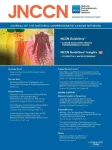(Press-News.org) PLYMOUTH MEETING, PA [September 5, 2024] — New research just-published online by JNCCN—Journal of the National Comprehensive Cancer Network finds that for many commonly used treatment regimens targeting metastatic gastrointestinal (GI) cancers, such as FOLFOX, FOLFIRI, or FOLFIRINOX, it is possible to administer 5-FU solely through continuous infusion, minus the bolus (quick-delivery via intravenous push) component, without negatively affecting patient outcomes.
The study reviewed results from 11,765 patients across 280 cancer clinics who were diagnosed with advanced colorectal, gastroesophageal, and pancreatic cancers between January 2011 and May 2022. According to the findings, there was no decrease in overall survival for the 13.7% of patients who did not receive a 5-FU bolus component as part of their treatment regimen. However, those patients did see a notable reduction in cytopenias, such as neutropenia (compromised immune system) or thrombocytopenia (bleeding problems).
“The true value of our findings lies in the empirical evidence they provide, which supports what many of us have long suspected,” said lead researcher Shun Yu, MD, NYU Langone Health. “The most significant benefit of this adjustment is that it makes the treatment more tolerable, potentially easing the chemotherapy experience for patients. For decades, the most effective treatment for gastrointestinal cancers was a combination of two forms of 5-fluorouracil: the 5-FU bolus injection, followed by the 5-FU continuous infusion. However, in the early 2000s, the standard of care evolved into multi-drug regimens after it was discovered that adding to the two-component 5-FU backbone significantly improved patient outcomes. While the value of the 5-FU bolus was well established in the older single drug regimens, its role in these newer multi-drug combinations was never thoroughly tested and was largely just assumed.”
The study points out that many practicing oncologists—particularly those who have been in practice longer or who specialize in GI cancers—have already begun to omit the bolus. Recent shortages of 5-FU have also highlighted the potential for reducing this bolus portion.
“This study offers solid evidence for not using a 5-FU bolus with FOLFOX/FOLFIRI/FOLFIRINOX regimens in advanced GI cancers,” commented Elena Gabriela Chiorean, MD, Fred Hutch Cancer Center, who was not involved in this research. “5-FU is a core component of treatment regimens for many gastrointestinal cancers and has traditionally been included as a bolus in addition to a 46-hour infusion in many multiagent chemotherapy regimens. However, there have been no clear evidence showing that bolus 5-FU confers additional efficacy when retained with 5-FU infusion in multi-agent regimens. The authors conducted a large retrospective cohort study to determine the safety and survival rates for patients with advanced colorectal, gastroesophageal and pancreatic cancers after multiagent 5-FU based chemotherapy with and without the 5-FU bolus from the start, adjusting for clinical factors such as age and comorbidities. This large study shows that omitting the bolus 5-FU has no detrimental effect on survival but reduces side effects and healthcare costs.”
A more detailed response from Dr. Chiorean, who is also a Member of the NCCN Clinical Practice Guidelines in Oncology (NCCN Guidelines®) Panel for Pancreatic Adenocarcinoma, will be publishing in the upcoming October 2024 issue of JNCCN.
Complimentary access is available to “Omission of 5-Fluorouracil Bolus from Multidrug Regimens for Advanced Gastrointestinal Cancers: A Multicenter Cohort Study.” To read the entire article, visit JNCCN.org.
# # #
About JNCCN—Journal of the National Comprehensive Cancer Network
More than 25,000 oncologists and other cancer care professionals across the United States read JNCCN—Journal of the National Comprehensive Cancer Network. This peer-reviewed, indexed medical journal provides the latest information about innovation in translational medicine, and scientific studies related to oncology health services research, including quality care and value, bioethics, comparative and cost effectiveness, public policy, and interventional research on supportive care and survivorship. JNCCN features updates on the NCCN Clinical Practice Guidelines in Oncology (NCCN Guidelines®), review articles elaborating on guidelines recommendations, health services research, and case reports highlighting molecular insights in patient care. JNCCN is published by Harborside/BroadcastMed. Visit JNCCN.org. To inquire if you are eligible for a FREE subscription to JNCCN, visit NCCN.org/jnccn/subscribe. Follow JNCCN at x.com/JNCCN.
About the National Comprehensive Cancer Network
The National Comprehensive Cancer Network® (NCCN®) is a not-for-profit alliance of leading cancer centers devoted to patient care, research, and education. NCCN is dedicated to improving and facilitating quality, effective, equitable, and accessible cancer care so all patients can live better lives. The NCCN Clinical Practice Guidelines in Oncology (NCCN Guidelines®) provide transparent, evidence-based, expert consensus recommendations for cancer treatment, prevention, and supportive services; they are the recognized standard for clinical direction and policy in cancer management and the most thorough and frequently-updated clinical practice guidelines available in any area of medicine. The NCCN Guidelines for Patients® provide expert cancer treatment information to inform and empower patients and caregivers, through support from the NCCN Foundation®. NCCN also advances continuing education, global initiatives, policy, and research collaboration and publication in oncology. Visit NCCN.org for more information.
END
A new UCLA-led study found that cardiovascular disease risk among Chinese American immigrants increases with length of residence and varies by location in the U.S. The study, which leveraged data from the MESA (Multi-Ethnic Study of Atherosclerosis) cohort, sponsored by the National Heart, Lung, and Blood Institute (NHLBI), observed the heart health of 746 Chinese Americans in both Los Angeles and Chicago over a period of roughly 18 years. The study found that participants who resided in Chicago showed lower mortality levels from heart disease compared to those who lived in Los Angeles.
“This is the first long-term prospective study in nearly two decades to investigate the effects of ...
Research Highlights:
In the first study, nearly 23% of young adults (ages 18-39 years) included in the NHANES 2017-2020 datasets had high blood pressure (130/80 mm Hg or greater). In addition, they were more likely to self-report being uninsured, food insecure and low-income compared to older adults.
The second study, which also used the 2017-2020 NHANES datasets, found that among 2,600 youths ages 8-19, 8.7% had elevated blood pressure and 5.4% had high blood pressure, as defined by age-sex-height percentiles in accordance with guidelines from the American Academy of Pediatrics.
These two studies point to the need for policies and programs to support youth and young adults ...
Research Highlights:
A new study finds that up to 74% of participants with resistant or difficult-to-control high blood pressure, including those with chronic kidney disease, were able to improve control of their blood pressure within 12 months after using a Bluetooth-enabled remote monitoring system coupled with pharmacist interactions.
Two-thirds of patients had interacted with pharmacists who co-managed their blood pressure via telehealth, often making medication adjustments and addressing medication adherence, which was associated with ...
Research Highlights:
An analysis of at-home blood-pressure monitors estimates that the arm cuffs for 10 of the most popular potentially do not fit up to 18 million adults in the U.S. and nearly 12% of Black adults.
To ensure accurate blood pressure monitoring, the researchers suggest that manufacturers and retailers be aware of the disparities and improve access and selection of diverse blood pressure cuff sizes for consumers.
Note: The studies featured in this news release are research abstracts. Abstracts ...
There are some pretty strange ingredients in cosmetics and skin care products. One example is snail mucin — also known as snail slime — which is used for its moisturizing and antioxidant properties. But researchers reporting in ACS Omega might have found something even weirder to put on your face: molecules made by fish gut bacteria. In cultured cells, the compounds had skin-brightening and anti-wrinkle properties, making them potential ingredients for your future skin care routine.
Though fish guts might seem like the absolute last place to look for cosmetic compounds, it’s not a completely far-fetched idea. Many important drugs have ...
How does your dip in a local watering hole affect the stream’s chemistry? Researchers who previously analyzed the impact of people swimming and tubing on a Colorado creek report updated observations in ACS ES&T Water. They find that these recreational activities over a busy Labor Day weekend have a short-term effect, increasing the levels of metals, human gut-associated microbes and substances from personal care products.
Researchers James Ranville, Carsten Prasse, John Spear, Noor Hamden, Carmen Villarruel and colleagues studied how recreational ...
Hong Kong (5 September 2024) – The Asian Fund for Cancer Research Limited (AFCR) is pleased to announce the winners of the 2024 BRACE Award Venture Competition: the First Prize goes to Concarlo Therapeutics, led by Founder and CEO Stacy Blain, Ph.D., and the Second Prize goes to Orphagen Pharmaceuticals, led by its Founder and CEO Scott Thacher, Ph.D.
AFCR’s BRACE (Bridging Research from Academia to Cancer Entrepreneurship) Award Venture Competition is designed to support and accelerate oncology innovations on their path toward commercialization, aiming to improve outcomes for patients affected by cancer globally. ...
Research Highlights:
In an analysis of 18 randomized clinical trials, people with obesity and high blood pressure who underwent bariatric (weight-loss) surgery were almost three times more likely to achieve blood pressure remission, defined as reducing to less than 140/90 mm Hg and no longer taking antihypertensive medication, and keep it under control in comparison to peers treated with medication and healthy lifestyle adjustments.
Over a 1-to-5-year follow-up period, people with obesity who ...
PULLMAN, Wash. — A new application that uses artificial intelligence may revolutionize the way scientists study hair and could lead to the development of health diagnostics based solely on hair.
The AI model speeds up and streamlines the hair quantification process, allowing a microscope to scan slides and collect images of hundreds of hairs at a time. In a matter of seconds, it can capture an abundance of high-resolution data that is then processed with a deep learning algorithm that collects the color, shape, width and length of each individual hair. Researchers tested it using mouse fur, but it could be ...
A combined 4.8 million euros in ERC Starting Grants will go to scientists at the Institute of Science and Technology Austria (ISTA). Awarded to early career researchers by the European Research Council (ERC), Starting Grants help researchers launch and develop projects, build capable teams, and pursue cutting-edge research. All three of ISTA’s ERC winners wholly embody the Institute’s curiosity-driven mission: they aim to find out how cells keep time, improve the way we date our stars, and optimize the extraction of relevant information from our ever-growing data.
ERC Starting Grants ...



